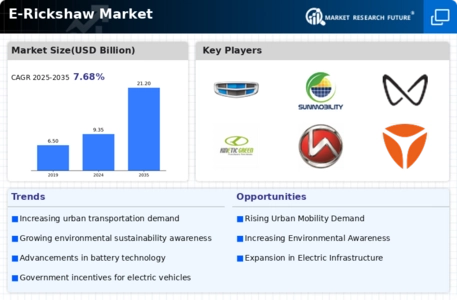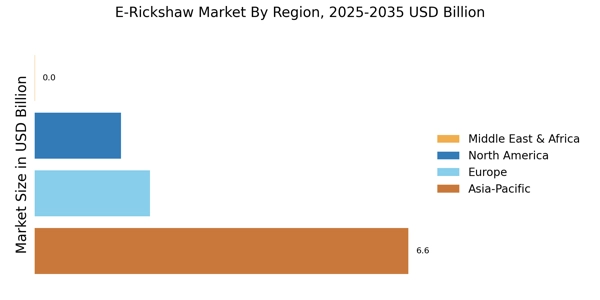Rising Fuel Prices
The E-Rickshaw Market is significantly influenced by the rising prices of conventional fuels. As fuel costs continue to escalate, operators are increasingly seeking cost-effective alternatives for transportation. E-Rickshaws, which operate on electricity, present a viable solution to mitigate the financial burden associated with fuel expenses. The operational cost of E-Rickshaws is considerably lower compared to traditional auto-rickshaws, making them an attractive option for drivers and fleet operators. This shift towards electric vehicles is expected to drive demand in the E-Rickshaw Market, as more individuals and businesses recognize the long-term savings associated with electric mobility. Consequently, the market is likely to witness a surge in adoption rates as fuel prices remain volatile.
Technological Innovations
The E-Rickshaw Market is benefiting from ongoing technological innovations that enhance the performance and efficiency of electric vehicles. Advances in battery technology, such as the development of lithium-ion batteries, are leading to longer ranges and shorter charging times for E-Rickshaws. These improvements not only increase the appeal of E-Rickshaws to consumers but also contribute to their operational efficiency. Additionally, the integration of smart technologies, such as GPS tracking and telematics, is becoming more common in E-Rickshaw Market designs. These features provide operators with valuable data on vehicle performance and route optimization, potentially leading to increased profitability. As technology continues to evolve, the E-Rickshaw Market is likely to experience a surge in innovation-driven demand, further solidifying its position in the transportation sector.
Urbanization and Population Growth
The E-Rickshaw Market is poised for growth due to rapid urbanization and population expansion in various regions. As cities become more congested, the demand for efficient and eco-friendly transportation solutions is on the rise. E-Rickshaws offer a compact and maneuverable alternative to traditional vehicles, making them well-suited for navigating crowded urban environments. According to recent data, urban areas are projected to account for a significant portion of the E-Rickshaw Market, as more individuals seek convenient transportation options. This trend is likely to be further amplified by the increasing awareness of environmental issues, prompting urban dwellers to opt for sustainable modes of transport. The convergence of urbanization and the need for efficient transport solutions is expected to catalyze growth in the E-Rickshaw Market.
Government Initiatives and Policies
The E-Rickshaw Market is experiencing a notable boost due to various government initiatives aimed at promoting electric vehicles. Policies that provide subsidies and incentives for electric vehicle adoption are becoming increasingly prevalent. For instance, certain regions have implemented tax exemptions and financial assistance programs for E-Rickshaw Market operators. This not only encourages the transition from traditional fuel-based vehicles to electric alternatives but also aligns with broader environmental goals. The market is projected to grow as these policies gain traction, potentially leading to a significant increase in E-Rickshaw Market registrations. Furthermore, the establishment of charging infrastructure by governments is likely to enhance the operational feasibility of E-Rickshaws, thereby fostering market expansion.
Environmental Awareness and Sustainability
The E-Rickshaw Market is increasingly influenced by heightened environmental awareness among consumers and policymakers. As concerns regarding air pollution and climate change intensify, there is a growing preference for sustainable transportation options. E-Rickshaws, which produce zero tailpipe emissions, align with the global push towards greener alternatives. This shift in consumer behavior is prompting both individuals and businesses to consider E-Rickshaws as a viable mode of transport. Furthermore, various environmental regulations are being introduced to limit emissions from traditional vehicles, thereby creating a favorable environment for the adoption of electric rickshaws. The convergence of consumer demand for sustainability and regulatory support is expected to drive significant growth in the E-Rickshaw Market, as more stakeholders recognize the benefits of eco-friendly transportation solutions.


















Leave a Comment